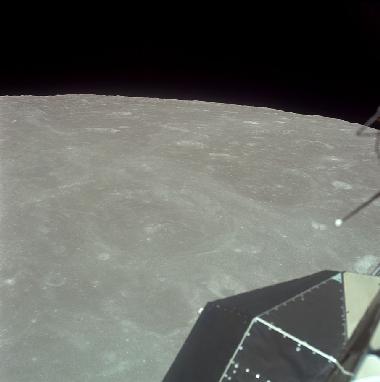-
 Buzz Aldrin (LMP)
Buzz Aldrin (LMP)
-
Houston, Apollo 11. Could you give us a time of crossing the prime meridian 150 west? Over.
-
 Bruce McCandless (CAPCOM)
Bruce McCandless (CAPCOM)
-
Roger. Stand by about a half a second, here. Okay. Your time of crossing the 150 west meridian will be 77 50 05. Over.
-
 Bruce McCandless (CAPCOM)
Bruce McCandless (CAPCOM)
-
11, this is Houston. We have about 6 minutes remaining until LOS, and in order that we may configure our ground lines, we'd like to know if you're still planning to have the TV up with the beginning of the next pass. Over.
-
 Bruce McCandless (CAPCOM)
Bruce McCandless (CAPCOM)
-
For use in connection with the prime meridian crossing, you have an orbital period now of 2 hours 8 minutes and 37 seconds. Over.
-
 Bruce McCandless (CAPCOM)
Bruce McCandless (CAPCOM)
-
Apollo 11, this is Houston. A little over 2 minutes to LOS. All your systems parameters and orbit are looking good from the ground. We have AOS on the other side at 78 23 31. Over.
-
 Charlie Duke (CAPCOM)
Charlie Duke (CAPCOM)
-
Apollo 11, this is Houston. Affirmative. We are reading you loud and clear on voice and we have a good clear TV picture, a little bright crater in the —
-
 Charlie Duke (CAPCOM)
Charlie Duke (CAPCOM)
-
And if you give us P00 and ACCEPT, we will uplink our new state vector and target load to you.
-
 Buzz Aldrin (LMP)
Buzz Aldrin (LMP)
-
Houston, Apollo 11. One of the larger craters on the back side—I noticed a small, dark speck on the outer wall and I put the monocular on it. I was able to see—oh, an area maybe a quarter of a mile in diameter. It was really a freshlooking dark colored pit, and that seems to be in contrast with all the other fresh little craters or holes that you can perceive on the walls of any of these craters. Around this particular one there seems to be two or three of these—especially the one that caught my attention. Quite remarkable. Over.
-
 Charlie Duke (CAPCOM)
Charlie Duke (CAPCOM)
-
We're getting a beautiful picture in down there now, 11. The color's coming in quite clearly, and we can see the horizon and the relative blackness of space, and without getting into the question of grays and browns, it looks, at least on our monitor, sort of a brownish gray.
-
 Buzz Aldrin (LMP)
Buzz Aldrin (LMP)
-
That's a good, reasonable way of describing it. It appears to me as though it made a difference just sitting back in the tunnel and gazing at all windows; it makes a difference which one you're looking out of. For example, the camera right now is looking out the number 5 window, and it definitely gives a rosier or tanner tinge, especially when you look straight through it and not at an angle. Over.
-
 Charlie Duke (CAPCOM)
Charlie Duke (CAPCOM)
-
Roger. And for your information, we show you at an altitude of about 92 miles above the surface right now.
-
 Michael Collins (CMP)
Michael Collins (CMP)
-
Houston, Apollo 11. Could you observe a difference in the N2 pressures before LOI? It seems to me as though the two were not equal on the … B tank was a little low on pressure. Over.
-
 Michael Collins (CMP)
Michael Collins (CMP)
-
I'm flying it in SPS minimum impulse, Houston, and it's rather difficult to keep it on a constant data. The LM wants to wander up and down. I'm not sure if it's in response to MASCONN's or what, but I can get it completely stabilized in DATA and let it alone, and in another couple of minutes it will have developed its own rate.
-
 Michael Collins (CMP)
Michael Collins (CMP)
-
Houston, we'll be moving shortly from the side window to the hatch window, and we'll try and pick up some of the landmarks that we'll be looking at as we approach the powered descent. Over.
-
 Charlie Duke (CAPCOM)
Charlie Duke (CAPCOM)
-
11, this is Houston. Roger. And we're through with the uplinks; the computer is yours. You can go to BLOCK and we'll have the information on nitrogen for you shortly. Over.
-
 Buzz Aldrin (LMP)
Buzz Aldrin (LMP)
-
Okay, Houston. Several minutes ago I was exactly steady on data, and since then I have been moving toward the LM, pointed straight down toward the radius vector, and that's been despite a number of down minimum pitch impulses.


